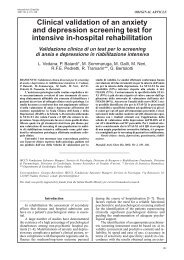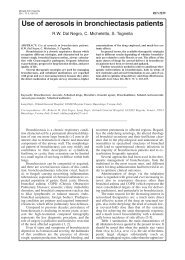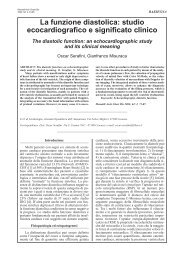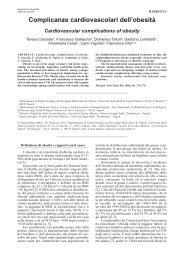Smoking Characteristics And Cessation In Patients With
Smoking Characteristics And Cessation In Patients With
Smoking Characteristics And Cessation In Patients With
You also want an ePaper? Increase the reach of your titles
YUMPU automatically turns print PDFs into web optimized ePapers that Google loves.
ease is associated with tobacco abstinence and progressive<br />
worsening with continued smoking. <strong>In</strong> a<br />
series of 89 patients with TAO, 52 (58%) continued<br />
to smoke and 37 (42%) stopped after diagnosis.<br />
Of the patients who stopped smoking, only 2<br />
(5%) underwent amputation in comparison with 22<br />
(42%) from the group that continued to smoke [6].<br />
However, a substantial number of patients with<br />
TAO continue to use tobacco despite progression<br />
of disease and amputation [7, 8].<br />
Descriptions of the smoking characteristics<br />
and the tobacco abstinence rates among smokers<br />
with TAO who received treatment for their tobacco<br />
use are scarce. The present paper describes a<br />
group of 27 cigarette smokers with TAO who received<br />
treatment in a tobacco intervention clinic in<br />
Spain. Analysis of smoking characteristics and the<br />
effectiveness and safety of tobacco interventions<br />
used are described.<br />
218<br />
Methods<br />
This is a descriptive, retrospective report of 27<br />
cigarette smokers suffering from TAO that attended<br />
a clinic specifically for treatment of their tobacco<br />
use from 1990 to 2004.<br />
The clinical records of all cigarette smokers<br />
identified with TAO that attended the clinic from<br />
1990 to 2004 were reviewed. <strong>In</strong>formation concerning<br />
demographic and smoking characteristics, including<br />
sex, age, age at onset of tobacco use, number<br />
of previous attempts to stop, number of cigarettes<br />
smoked daily, number of pack/years, FTND<br />
score and expired air carbon monoxide (CO) were<br />
collected. The type of tobacco treatment medications<br />
received, side-effects of these treatments and<br />
self-reported tobacco abstinence rates verified by<br />
expired CO at 2, 4, 8 and 12 weeks, 6 and 12<br />
month follow-up were abstracted and analysed.<br />
The tobacco intervention used consisted of the<br />
combination of behavioural and pharmacological<br />
treatment. The behavioural treatment was delivered<br />
in eight individual visits: an initial visit and<br />
seven follow-up visits. At the initial visit medical<br />
and smoking histories were obtained. The patient<br />
received intensive behavioural counselling, selfhelp<br />
materials, and a quit date was chosen. The<br />
strong relationship between TAO and tobacco consumption<br />
and tobacco abstinence as the most important<br />
aspect of treatment of TAO was emphasised<br />
to the patient. Pharmacological treatment<br />
was prescribed and patients were instructed in appropriate<br />
use. The initial visit lasted approximately<br />
25-30 minutes.<br />
At follow-up visits patients received additional<br />
intensive individual counselling. <strong>Patients</strong> were<br />
instructed in how to cope, manage stressful situations,<br />
and prevent relapse. Continuous abstinence<br />
and 7-day point prevalence abstinence and adverse<br />
effects of the medication were assessed. Each follow-up<br />
visit lasted approximately 10-15 minutes.<br />
Continuous abstinence was defined as not smoking<br />
even a puff from the quit-date. An expired air CO<br />
of ≤5 ppm verified self-reports. Point prevalence<br />
abstinence was defined as not smoking during the<br />
C.A. JIMÉNEZ-RUIZ ET AL.<br />
last seven days and this self-report was verified by<br />
an expired air CO of ≤5 ppm.<br />
Pharmacological treatment consisted of combinations<br />
of nicotine patches, nicotine gum and/or<br />
bupropion for 12 weeks. Ten patients received a<br />
combination of 16-hour nicotine patches and nicotine<br />
gum. Seven patients received a combination<br />
of 24-hour nicotine patches and nicotine gum. Ten<br />
patients used a combination of 16 hour nicotine<br />
patch, nicotine gum and bupropion.<br />
Statistical Analysis<br />
A descriptive analysis of the variables was performed.<br />
We did an ‘intent to treat’ analysis, considering<br />
those lost to follow-up as smokers. Measurements<br />
of qualitative variables are expressed in absolute<br />
values and as percentages, while measurements<br />
for continuous quantitative variables are given<br />
as means and standard deviations. Qualitative<br />
variable relationships were tested using the χ-square<br />
test for independence, or Fisher’s Exact Test when<br />
expected values were less than five. Statistical significance<br />
was accepted at a level of p











